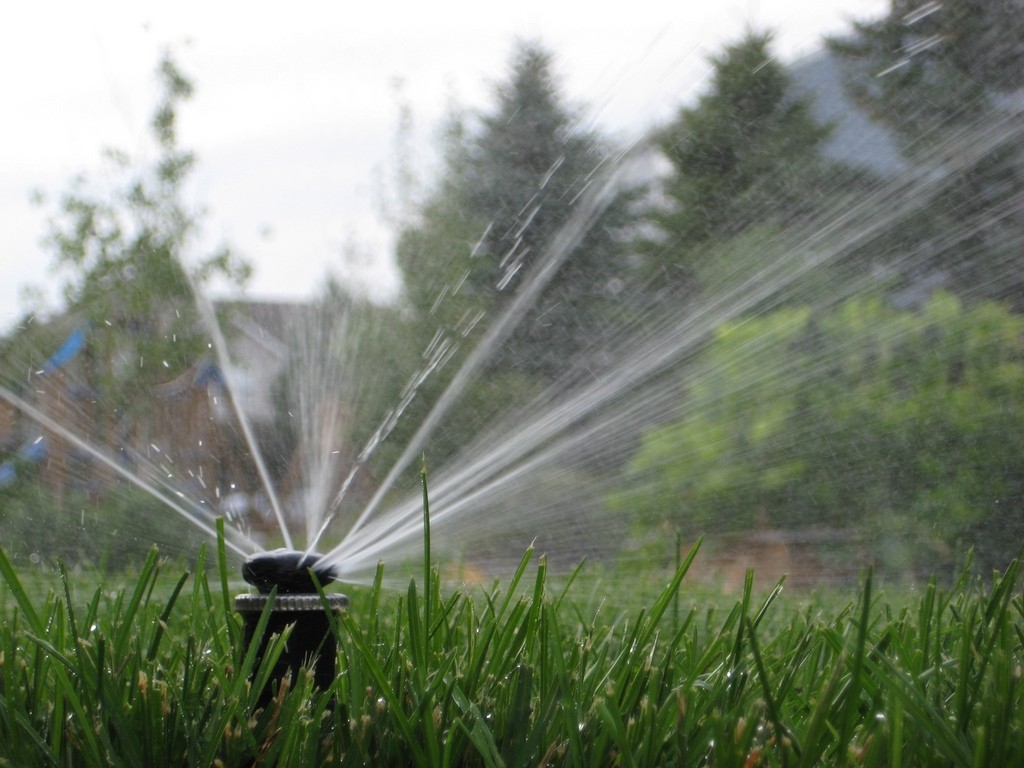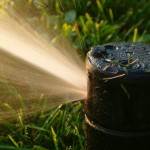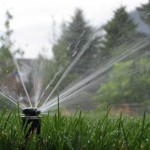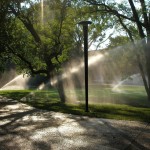
An effective sprinkler system is a vital part of a healthy lawn—especially in the hot, dry months, and Texas has plenty of those. When working effectively, sprinkler systems make the process of keeping your grass lush and green nearly effortless.
However, even an excellent sprinkler system can break. If your sprinkler system will not turn on, the first thing you need to do is identify the issue at hand. After you know what is wrong, you can determine whether it is something you can fix on your own or if it is time to call in a professional repair technician or two—like our team at Texas Rainmakers.
Common Reasons Sprinklers Won’t Turn On
There are many potential reasons that a sprinkler system won’t turn on, but a few are more common than others. Here are the most common culprits. We started with the easier to fix problems first.

Issues with Sprinkler Heads
Dirty Sprinkler Head
Dirty sprinkler heads are the most common reason that a sprinkler won’t turn on. Because sprinkler heads are so low to the ground, they can become clogged with dirt and debris that plugs them and stops the water from spraying out. If just one sprinkler head is clogged rather than several, a dirty sprinkler head is likely to blame.
Cleaning off a sprinkler head is something that you can often do yourself. Before you start, you should turn off the water supply.
Then, gently lift the sprinkler head a bit off of the ground and wipe it with a damp rag. If that does not work, we recommend following the directions in the manual you received when purchasing your sprinkler system.
User manuals typically make one of a few suggestions. You can take a small, sharp object, such as a screwdriver or thin wire, and stick it into the spigot to carefully remove any dirt stuck there.
Some sprinkler models also have heads that can be taken apart. If you have one of these models, another possibility is to remove the head and wash it off or soak it in soapy water to remove any remaining dirt.
Broken Sprinkler Head
If you clean the head and it is still not working, you may be dealing with a broken sprinkler head. Of course, you will be able to notice this quickly if the head has snapped off entirely. This can happen if someone accidentally mows the lawn over the sprinkler heads.
In other cases, you will have to look at it more carefully. Even a small crack in the plastic casing can cause a problem and may require a replacement.
Issues with the Control Panel
Automatic Sprinkler Control Panel
If you have your sprinkler system set up with a control panel, the issue may not be with your sprinklers themselves. Many homeowners have their sprinklers set up with an automatic timer to create a daily watering schedule. The clock on a sprinkler system may have reset if it is connected to the home’s power, and there was a power outage, or, if it is battery powered, due to a dead battery. Simply resetting the clock or replacing the batteries will help you determine whether you have a broken sprinkler or a temporarily disabled control panel.
Issues with Valves
To sort out whether you have a problem with your valves, you first need some background knowledge about your valve box. For most homeowners, a sprinkler valve box contains both the manifold and the valves. Many people have their valve boxes installed close to their houses on their property. Typically valve boxes have a firm plastic cover. Although the contents of different valve boxes are not exactly the same, they are generally structured in one of a few ways.
Once you have opened the valve box, you will see the manifold. The manifold is the tube that takes the water supply and distributes water to each separate valve. There is also a pump control valve, which balances the start and stop of the water flow so as not to overwhelm the system.
Valves Are Off
Often, the problem is with the valves that are running your sprinkler system rather than the spray heads. If your sprinkler heads are not spraying or have very low water pressure, it is important to check your backflow device to see if the valves are turned on correctly.
You can turn a valve on manually by moving the solenoid one-quarter turn counter-clockwise. The solenoid is a magnetic wire coil that opens up the valve in a functioning system. In most systems, it is a black cylinder with wires sticking out of it. Usually, this will turn on the valve, and water will start to flow out of your spray heads.
Every so often, the solenoid will not twist easily. You can solve this by loosening the bleeder screw, which is a smaller screw that is also attached to the valve. It is common for some water to leak out after the bleeder screw is loosened, which is completely fine.
Broken Valves
If none of your sprinkler heads are working and the valves are set up correctly, they may be broken. To determine if a valve is broken, you will need to test for resistance. Testing for resistance will require a multimeter as well as the user manual. If you don’t have a multimeter, you can purchase one at most department or hardware stores for less than $20.
Disconnect the solenoid wires.
After removing the solenoid, you can use your multimeter to measure the resistance in ohms, which is represented by the omega symbol. Compare the number you get to the one in the user manual. If your number is significantly lower than the one listed, the solenoid is most likely burned out. In this case, the best option is to replace it.
When replacing the solenoid wires, make sure that the power to the system is off. Following that, you will open the control valve box, remove the solenoid from the wires, unscrew it, and replace it.
Flow Control
Some valves also have a flow control screw. The purpose of the flow control knob is to restrict the stroke of the diaphragm, which prevents too much water from passing through. In some cases, it is important to tighten the screw somewhat because too much water pressure would overwhelm the sprinkler heads. However, if water is barely trickling out and your flow control screw is already partially turned, it may need to be loosened all the way to allow for good water pressure throughout the system.
Issues with Pipes
Damaged or Leaking Pipes
Even though your pipes may be out of sight, they can still be a part of the problem. If you do not think the issue has to do with the sprinkler head or the backflow device valves, it may be time to check out your pipe system.
Pipes are often damaged by expanding tree roots or ground shifting. To see if a pipe is broken and leaking, turn on the water supply and check the area for any puddling or signs of underground moisture, such as saggy soil or greener spots along the lines. This process can help to pinpoint the specific area you will need to dig up to replace the leaking pipe.
Sometimes, a pipe is not fully broken, but it is damaged enough to impact the efficacy of your sprinkler system. If you cannot figure out exactly where to start digging, we recommend starting near either a sprinkler head that is not working (and does not have one of the previously listed issues) or by a tree that may be interfering with the sprinklers. Fixing a damaged pipe will improve water pressure by improving the connection between the sprinkler heads and the water supply.
When you find the damaged piece, the easiest fix is to cut the damaged piece out and replace it. However, if you realize that the location of the pipes may cause future problems, it may be better to restructure the pipes in that whole area.
Issues with Voltage
If the heads in some areas are turning on but others are not, you could be having an issue with voltage. If you have a sprinkler system set up in various areas of your property, a different electrical valve runs each zone. If just one of your zones is not working, that could mean that a circuit breaker is switched off or damaged. To start, check to see if the circuit breaker of the main panel is on.
Another option is to assess the zone wires. To do this, you will also need your multimeter and user manual. This time, however, you will need to put the multimeter on the voltage setting and test the zone wires. You will compare the number of volts you detect to the range in the user manual. If the numbers do not match up, you will need to get a new controller for the area.
If there is a voltage problem with the whole system, the cause is more likely related to the transformer. It is possible that the transformer simply is not plugged in. If that’s the case, make sure that the power system is off before plugging it in. If you plug in the transformer and it still is not working, you may have a faulty transformer.
Upgrading Your Sprinkler System

If you are in need of sprinkler replacement or repair, why not upgrade your sprinkler system altogether? Not only are the new smart sprinklers more convenient than older models, but they can also save you money on your water bill in the long run.
Wireless Control
One of the biggest advantages of smart sprinklers is that they are controlled wirelessly. You can connect to your system using your phone, tablet, or computer and make changes wherever you are, whether that’s on vacation 700 miles away or 7 feet away on your couch, and you just don’t want to leave your AC.
Rain Sensors
Many smart sprinklers have a rain sensor. The rain sensor works with your sprinkler and irrigation system to detect the specific amount of water your lawn needs on a given day. If a rain sensor detects that there has already been sufficient rainwater, your sprinkler will skip the following watering cycle. This feature is crucial in saving water, which is good for both the environment and your wallet.
Adjust Sprinkler Coverage
Another way smart sprinklers can help you save water is by tailoring the coverage to make sure all of the water is getting to your plants rather than your driveway or porch. This is not only a hassle, but it is also an inefficient use of water.
Automatic Scheduling
A significant plus of a smart sprinkler is the option for automatic scheduling, which allows you to set up a watering routine. You can also change these settings just as easily. Many homeowners choose to vary their watering patterns for different seasons throughout the year.
DIY or Hire a Sprinkler Repair Company?
Many homeowners repair small issues with their home sprinkler systems on their own. With some working knowledge of sprinkler systems and your water supply, you can take care of your sprinkler repair problems in no time.
In other situations, such as more technical valve issues, it is best to contact a licensed professional sprinkler and irrigation system repair company. When you call us at Texas Rainmakers, you get a company with over 20 years of experience in the business.
Our team of committed technicians can help you fix whatever sprinkler system problem you are having, as well as advise you on how to proceed. As a local family-run business, we understand the unique challenges Texas homeowners face when trying to maintain a healthy lawn in our hot, dry climate.
Texas Rainmakers stands out because we also provide several other landscaping services, including irrigation, backflow testing, mosquito control, and landscape lighting. Call us today at 281-852-4331 for a free quote.



























